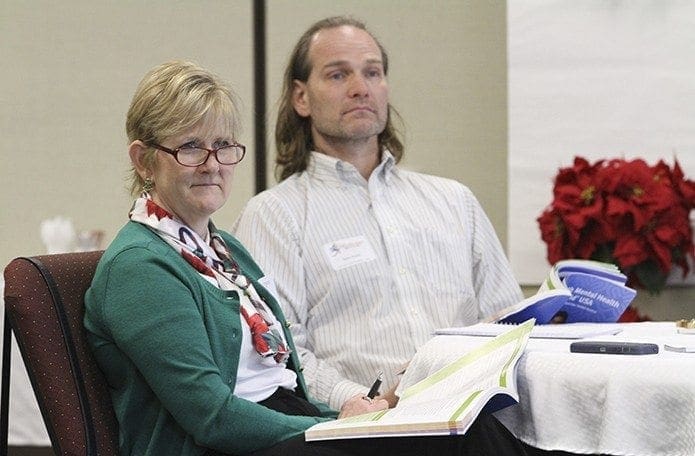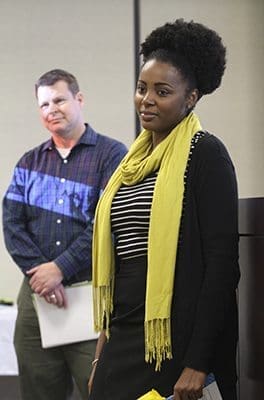 Photo By Michael Alexander
Photo By Michael AlexanderSmyrna
Parish ministers get training in mental health ‘first aid’ for teens
By NICHOLE GOLDEN, Staff Writer | Published January 7, 2016
SMYRNA—More than 20 parishes took advantage of special training offered in December that will help staff support young people with mental health problems and their families.
Youth ministry directors and volunteers, deacons and others attended Youth Mental Health First Aid USA training programs Dec. 10 and 14 at the Chancery of the archdiocese.
The archdiocesan Disabilities Ministry and the Center for Leadership in Disability at Georgia State University offered the eight-hour training sessions in response to increasing episodes of violence associated with mental illness.
The training outlines how to provide initial and valuable support to young people. It is not designed to diagnose or treat mental illness but to recognize signs and urge families to receive appropriate help to avoid a crisis. Its focus is on helping adolescents 12 to 18 years old.
Maggie Rousseau, director of the Disabilities Ministry, said the program provides youth leaders training to confidently respond to families or just to be able to identify a problem or diffuse a situation.
She recalled Archbishop Wilton D. Gregory’s encouragement in a recent homily to reach out to the unseen, including those affected by mental health problems.
“I really felt called to do something. We can really reach youth at a critical time,” said Rousseau. She emphasized that those struggling with mental illness still have the possibility to lead a great life.
The training is funded as part of Georgia Project AWARE, a $10 million grant to the state Department of Education in partnership with the Substance Abuse and Mental Health Services Administration.

Breanna Kelly, foreground, a behavioral specialist at Georgia State University, Atlanta, and Andy Roach, background, an associate professor in the department of counseling and psychological services at Georgia State University, jointly lead the Youth Mental Health First Aid USA training session at the Chancery Dec. 10. The program is a collaborative effort between the archdiocese’s Disabilities Ministry and the Georgia State Center for Leadership in Disability. Photo By Michael Alexander
Andrew Roach, Ph.D., associate director of the Center for Leadership in Disability, said in the wake of the Sandy Hook school shootings, the federal government took a variety of actions on mental health awareness, including awarding SAMHSA grants.
“Georgia was really fortunate to be one of those states to get grants,” said Roach. “It’s really important we’re able to talk about mental health issues.”
An associate professor at Georgia State, Roach is a former elementary and middle school teacher. He co-presented the training with Breanna Kelly, behavioral specialist and licensed master social worker.
Participants took part in role-playing for adults who work with teens and exercises that matched symptoms to disorders ranging from depression to anxiety.
Roach said the training’s purpose is two-fold: it addresses stigma associated with mental health problems and gives youth leaders tools such as open listening skills.
Teen years can be turbulent with transitions in academics, relationships, hormonal changes, and new responsibilities and stressors.
“Think about the things that change during that time,” said Kelly.
Distinguishing between what is a normal part of growing up and a true problem can be key in early intervention, emphasized the presenters.
A mental health disorder or illness affects thinking, emotional state and behavior and disrupts school, daily activities or the ability to engage in satisfying relationships.
A typical and normal behavior of teens is to withdraw from family to spend more time with friends. If a young person withdraws from all interests and relationships, that’s a sign of a problem.
“When all activities cease, when kids are like ‘nope’ and there’s no replacement, that’s where we run into trouble,” said Roach.
Parish family can be a protection for teens
As participants introduced themselves to others, the instructors had each person indicate what they were grateful for in life.
Often participants will say they are thankful for family or faith, indicating some of the protective factors that help youth and all people adapt to change, to cope and turn to others for help.
The protective factors for youth also include good self-esteem, avoiding alcohol and drugs, parental monitoring, regular school attendance, and a good social support system.
“Clearly, I think one of the purposes of your work is to provide that good social support,” Roach told the youth leaders.
The parish family can be a protection against a mental health crisis, offering bonding, others to feel a connection with, and constructive activities.
Participant Darleine Arce, youth director at St. George Church in Newnan, discussed the parish’s strengths.
“It’s a welcoming community,” Arce said.
If someone is absent, it’s common to hear something along the lines of, “Hey, where were you? You were missed,” she said.
Arce said that a parishioner who is a counselor spoke to the youth group following a suicide in the community and at other times to cover warning signs of depression, coping skills and other topics.
“That’s actually been very helpful,” she said.
Those taking the training course received manuals outlining symptoms of various illnesses, the prevalence of mental health conditions, helpful resources specific to the disorder.
In the “Find Your Match” game, youth leaders matched symptoms of attention deficit disorder, eating disorders, and other illnesses to the condition name. The game heightened awareness of what the struggles are.
“We’re seeing a lot more of the young men with eating disorders,” said Roach. “It’s something that’s really rapidly changing.”
An auditory hallucination activity simulated what it’s like for a person who hears voices or has obsessive thoughts to try to function in the real world.
“That gave us a glimpse of how difficult that can be to focus on a teacher,” explained Kelly.
While one student attempts to have a conversation with a teacher, another whispers constant comments from a script into his ear.
Kelly told trainees that internal dialogue such as “look both ways” or “I shouldn’t eat that” is something we all have.
“There’s a difference when it’s becoming disruptive,” she said.
In addition to hallmarks of disease, the prevalence in a given year was also outlined.
“Twenty-two percent of our young people—from ages 13 to 18—some time during that period experience a significant mental health crisis. So one in five really,” said Roach.
In the United States, about 57 percent of the population will have a diagnosable mental health disorder in their lifetime, according to the U.S. Department of Health and Human Services.
Mental health professionals are also educating the public more on recovery from traumatic events.
Trauma can include a health crisis, loss of a loved one, witnessing a violent act, experiencing family violence, surviving a weather related event, or even hearing more about mass shootings and other acts.
“Lots of people experience trauma without developing mental health issues,” noted Roach. But he noted that anxiety disorders related to traumas are becoming more prominent.
‘We are not always aware if our teens are struggling’
Youth leaders memorized the acronym ALGEE to serve as a reminder of the action plan to use and share with others on the parish level. The acronym stands for: assess for risk of suicide or harm; listen nonjudgmentally; give reassurance and information; encourage appropriate professional help; and encourage self-help and support strategies.
When working with youth, problems discussed can remain confidential unless they are harming themselves or others.
In event of a threat of suicide or harm to oneself, those who work with youth must always err on the side of caution, said Roach.

(Clockwise, from foreground right) Edgar Otero, the director of religious education at St. Patrick Church, Norcross, Elaine Phillips, director of elementary and high school religious education at St. Thomas More Church, Decatur, Darleine Arce, youth minister at St. George Church, Newnan, Marycelis Otero, a catechist at St. Patrick Church, Rebecca Capezzuto, director of faith formation at Holy Trinity Church, Peachtree City, and Sofia Martinez, a youth leader at St. Patrick Church, did a number of activities and role-playing exercises during the training session. Photo By Michael Alexander
“This should always be seen as a cry for help. You need to take immediate action,” he said.
Another activity presented different scenarios of concern, and participants discussed ways to approach the teen in each case.
Elaine Phillips, director of elementary education and high school youth at St. Thomas More Church in Decatur, found the exercise helpful as one had to develop different responses for each circumstance.
Phillips said the program overall was excellent.
“As a youth minister, we are not always aware if our teens are struggling with mental health issues,” she said. “I think part of it is that the parents don’t want to tell any more than they have to for fear of embarrassment or perhaps the fear that their child won’t be able to attend youth group.”
Mental illness is still very misunderstood in society and the term itself carries stigma, she said. Often Phillips doesn’t find out a teen has a diagnosis until medications are listed on permission forms for a trip.
“What I loved about the program was that it alerted us to some of the warning signs and some ways to support the teen and family,” she said.
Phillips added that the program would be beneficial for all youth ministers to take and a good course for parents at the parish.
Youth leaders were encouraged to be upfront about their role, learned when and how to involve parents, and to know their limits and the importance of referring a family to comprehensive care.
Youth leaders also learned to think of activities that incorporate and work for both youth who are typical and those who struggle in classroom settings. Youth ministers have to balance needs of the group with those of the individual who may not feel included or who is disruptive.
Many teens are hesitant to ask for help and so parents and youth ministers are encouraged to be more approachable. If red flags are seen in how youths are behaving or interacting, instead of asking, “What’s wrong” ask, “Has something changed?”
Teens frequently get pegged as not being good listeners, but it works both ways, noted Kelly.
“Sometimes we do it to them,” she said.
Effective communication with young people includes being genuine, allowing time for silence, trying another activity such as walking the dog while conversing, and avoiding comparisons from your own youth. Providing positive feedback for willingness to share is vital.
When adults don’t make themselves available to young people, it will affect whether or not they come for help the next time.
“They remember how you make them feel,” said Kelly. “It’s empathy, empathy, empathy.”